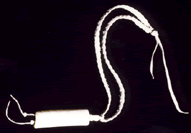| |
|
Anthony
is from the Sandy Bay First Nation. He is a self-taught carver and
artist. At the age of five, he won a Christmas stamp contest organized
by the Canada Post office. The image of an elfish Santa appeared on
a five-cent stamp.
For
the past six years he has been making a living by carving with moose
and elk bone. Carving is a creative process. He is becoming more aware
of the different styles and designs he can work with."I carve
mostly Eagle Feathers because it represents strength and power".
He
carves items for jewelry, such as earrings and necklaces. He uses
silver hooks for the earrings, also he incorporates beads and leather
into his necklace designs. He creates letter openers with wood and
driftwood. He also makes products such as walking sticks and frames.
Each piece is different.
One
of his carvings placed second in the Winnipeg Friendship Centre's
art competition in November 1998. Anthony has reproduced carvings
from the 19th century for Parks Canada.

|
|
5-CENT
STAMP
Anthony Martin expressed his artistic talents at an early age.
At 5-years-old Anthony was the winning designer of a 5-cent stamp
for the Canada Post Office. Out of more than fifty thousand entries,
Anthony's stamp was selected as 1 of 12 that would be presented
that year. It is estimated that in total there were 220 million
5-cent stamps distributed that year and 44 million were Anthony's.
|
 |
As
displayed here, intricately beautiful carvings were produced from
bone of elk and moose. Each piece, being individually hand carved,
took hours of painstaking craftsmanship. A sacrifice Anthony is
gladly willing to make in order to share his work with others,
as his work is distributed internationally. Produced from the
larger bones, each carving is six inches in approximate length.
Each retains its natural colour composition.
|
| Depicted
here, eagle feather carvings approximately two and four inches respectively.
Used for crafting earrings and necklaces worn by traditional dancers.
Their small size makes them especially challenging, they serve as
a testament to Anthony's patience, skill and determination as an
Aboriginal artist. |
|
 |
 |
|
This
beautiful decorative display piece is produced from all natural
Caribou bone, sinew and.leather. Obtained from Aboriginal hunters,
Anthony succeeds in recreating the beauty and pride of this once
plentiful creature. Constructed with only saw and file, hard work
and inspiration come naturally to this young and truly gifted artist.
|
|
A
bolo, center for a necklace, this traditional piece was created
for practical purposes of costume design.
Representing
the symbolic importance of the eagle to Aboriginal cultures, the
eagle is his primary inspiration.The bone is itself as hand carved,
and the discolouration is due to the nature of the material. Approximately
six inches in length, it is a powerful, simple, yet elegant representation
of the spirituality of the artist himself, Anthony J. Martin.
|
|
 |
 |
|
Bone
carved earrings, often used in conjunction with colored beads and
other traditional materials are used for the purpose of authenticated
costume design. Retaining their natural color, they are a powerful
representation of Aboriginal culture, and traditions, where every
part of the animal is sacred and nothing is wasted. |
 |
One
of the many places Anthony Martin's work has been displayed would
be at the Red River Exhibition in Winnipeg, Manitoba, Canada. Viewed
by the many thousands in attendance his work conveys a style that
is genuinely traditional in content. |
 |

|
|

